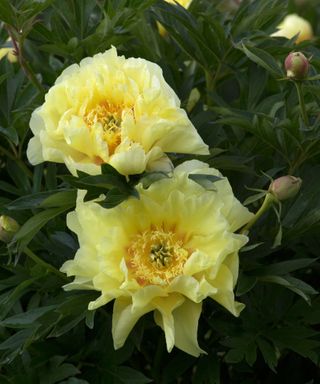How to grow peonies
Find out how to grow peonies to enjoy these glorious and long lasting flowers that add timeless elegance to any garden


Knowing how to grow peonies should be high on the list of priorities for any gardener, as the beauty of these long standing favorites of the flower border is almost unsurpassed.
The flush of voluptuous peonies each year may be short but they are highly anticipated for their impressive, dinner-plate sized blooms, and many have a lovely fragrance.
Few other plants have such large blooms, with a range of colors from pure white, through yellow to coral, pink and deep crimson, and a choice of single, semi-double and double forms.
Try growing peonies as flower bed ideas to add color, luminosity and elegance, as cut flowers, or you could also make a peony border to edge a path, or enclosed in low hedging.
Each year, peonies will die down in winter before emerging in spring with their crimson flushed foliage, appearing to grow before your eyes and then deliver an eye-catching exquisite display. So they are definitely a flower to add into the mix of your garden ideas.
Delicate and beautiful, once know when to plant peonies, understanding how to grow them in your backyard is crucial.

How to grow peonies – different varieties
There are three types of peonies, or paeonia: herbaceous, intersectional and tree.
When growing peonies, if you choose early, mid and late flowering plants, you can have a six-week flowering season, mid-May through June.
- Herbaceous peony: These classic and timeless perennials produce the large blooms we see in borders and beds and the plants have a bushy, compact shape, which die back every winter.
- Tree peonies: Are shrubby, reach a height of around 1.2m, and are the only ones that don’t die down at the end of the season. They bloom from early April to late May.
- Intersectional peonies: The rarer, more expensive intersectional peonies are a cross between tree and herbaceous and tend to have intense color with long-lasting blooms, and usually finely cut foliage.
The popular herbaceous peonies are a great choice when you are planning a cut flower garden as their stunning flowers will reappear year after year.
Peonies are available as bare-root plants, usually two years old that will not flower the first year.
You may, however, prefer to buy an established mature containerized peony plant, at least five years old, ready to flower in the first year.

Are peonies easy to grow?
Peonies are easy to grow, low maintenance, extremely hardy and offer decades of charm, with some producing blooms for 100 years.
When you grow peonies for the first time, it may take up to four years of patience before you see your first bloom, but their robust longevity and ease of care make them extremely worthwhile additions to your garden design.
There are many myths about growing peonies – but mostly they are unsubstantiated and if you follow some simple rules and take care with growing peonies then you will be rewarded with their stunning blooms, year after year.
'If peonies are given fertile soil, adequate sunlight, and good air circulation, they are both easy to grow and extremely long-lived,' explain the experts at American Meadows.

When to plant peonies?
As many peonies are grown from bare root plants that are lifted in fall, bare-root peonies are best planted in fall, while the soil is still warm and ideally as soon as they arrive.
'Be sure to plant your peonies at least one month before the ground in your area will freeze solid,' advise the experts at American Meadows, as this allows the roots sufficient time to establish before the arrival of winter.
You can also grow peonies in early spring, they add, but your young plants will need plenty of watering if it's a dry summer. 'Spring planting typically results in a slower growth in the first summer season,' they advise.
Container-grown peonies, which have been lifted and potted, can be planted at any time that the soil is workable, though late spring to summer is good.

Where do peonies grow best?
Peonies grow best when they enjoy certain conditions where they are planted:
- Peonies grow best when they are planted in full sun, but some species and the red flowering varieties will grow happily in light, dappled shade. Tree peonies need a sheltered spot.
- It is important to plant peonies in free-draining soil, advises Alec White of Primrose Hall Peonies .
- Clay soil is fine if it doesn’t stay wet, and peonies are also happy in chalk soils, but not in sandy as there aren’t enough nutrients.
- The majority of herbaceous peonies prefer neutral or slightly alkaline soil; a 6.5 – 7 pH is ideal, while tree peonies are more tolerant of acid soils.
- They need plenty of water but don’t plant in ground that becomes waterlogged as peonies won’t tolerate this.
- Don’t allow your soil to dry out in the spring as this may cause the plant to abort its young buds; they are quite drought-tolerant in summer, though.

How to plant peonies
Prepare the ground to a depth of 18in (45cm) and add about 6in (15cm) of well-rotted manure or compost. Peonies will reward you if given a good start in life. They will grow to be about 1m x 1m, so allow space for this.
Plant carefully with the crown no more than 2in (5cm) below the surface, the 'eyes' facing upwards. If the peonies are planted too deeply, they will produce lots of foliage but no flowers.
The experts at American Meadows advise planting the eyes 1-2in below the surface of the soil if you live in a colder zone, but 1in or less if you live in a warmer zone, to maximize the plant's exposure to colder winter temperatures.
If growing a group of peonies, plant them about 30in (75cm) apart to not crowd the crowns and keep a good airflow.
'Don’t plant your herbaceous or intersectional peonies too deep, and over mulching is a common cause for a peonies to not flower,' explains Alec White.
Water in your plants, but don’t overwater. They will take three years to bloom well, but as they will live such a long time, you can take them with you if you move house.

How to care for peony plants
Although they are fairly low maintenance, there are a few ways to take care of your peony plants and make sure they bloom beautifully every year.
- Remove weeds by hand as if you hoe, you can damage the feeder roots, which lie just below the surface of the soil.
- To dramatically increase the size of the plant and the flowerheads, disbud the plant for the first three years of growth when the buds are pea size. This will help the plant to bulk up quickly and not waste its energy producing that bloom.
- There is a myth that peonies can’t be transplanted and moved, but if you get them out of the ground when they are dormant, in fall, disturbing the rootball as little as possible, and plant them as soon as you can, they will be fine.
- Don’t plant peonies back in the same spot unless you remove the soil around the plant and replace it with new soil.
- You can divide them when they are lifted; cut cleanly and have three stem buds or eyes on each section.
- In fall, when the peonies have died back, cut the foliage to the ground and dispose of it. Botrytis, or peony wilt, will overwinter in dead foliage and may attack young, fresh growth the following spring.
- If your soil is rich and fertile you won’t need to feed them; otherwise, feed your peonies once a year in spring, summer or fall with a balanced, general fertilizer.
- Being very hardy they don’t need any winter protection, in fact, the cold starts the dormant period when they store their energy in their roots where the buds are forming.

Do peonies come back every year?
Peony are perennials so their flowers will come back every year.
They may not have the flowering span of many other summer flowers, but when peony are in bloom they have a stunning presence that will keep returning, without much fuss, for 60 to 70 years.
So while peonies are generally more expensive than roses, for example, think of these aristocratic plants as a long-term investment for your flower bed ideas.
It is easy to see why in China, peonies are known as the king of flowers, and have been cultivated there for thousands of years.
How to grow peonies from seed
If you're wondering whether can grow peonies from seed, there are good reasons why many gardeners choose not to try this method.
While it is possible to collect seed from your peonies when the pods are really ripe, it will take five to seven years to produce a flower, most seed is infertile, they need two years to germinate, and may not be true to form. So this is not an option for the fainthearted!
Sign up to the Homes & Gardens newsletter
Decor Ideas. Project Inspiration. Expert Advice. Delivered to your inbox.

Leigh Clapp is a professional photographer with over 25 years experience, primarily as a garden specialist photojournalist but also with food and travel. She delights in exploring gardens, discovering the tiny elements to their overall essence and meeting lots of enthusiastic gardeners along the way. Leigh’s work appears in magazines, newspapers and books, both in the UK and abroad, including Period Living, Country Life, and Gardens Illustrated; as well as being sole photographer for a number of books, including Garden Details, Feng Shui in the Garden, Vertical Gardens and From the Garden – fresh seasonal cooking.
-
 How to hide a trash can in a kitchen – 5 tricks to beautify a kitchen
How to hide a trash can in a kitchen – 5 tricks to beautify a kitchenInterior designers and kitchen planners explain how to hide a trash can in a kitchen to help improve the aesthetics of the room without
By Chiana Dickson Published
-
 Sherwin-Williams' latest color palette is inspired by Impressionism – combining 5 soft shades that are perfect for summer
Sherwin-Williams' latest color palette is inspired by Impressionism – combining 5 soft shades that are perfect for summerInspired by Impressionism, Sherwin-Williams' latest color palette is a selection of natural shades that are perfect for summer – here's how to decorate with them
By Emily Moorman Published
-
 Water garden ideas – 9 ways to introduce soothing water to your outdoor space
Water garden ideas – 9 ways to introduce soothing water to your outdoor spaceFrom cascading fountains to wildlife ponds, there are plenty of ways to create a tranquil water garden
By Leigh Clapp Published
-
 How to grow poppies
How to grow poppiesFind out how to grow poppies to enjoy the beauty of these brightly colored tissue paper-like blooms
By Leigh Clapp Published
-
 How to grow delphiniums from seed
How to grow delphiniums from seedFind out how to grow delphiniums from seed and enjoy these colorful cottage garden favorites filling beds and borders
By Leigh Clapp Published
-
 How to grow ferns – when and how to plant and care for them
How to grow ferns – when and how to plant and care for themLearn how to grow ferns to enjoy the texture and form of these versatile plants in many areas of your garden
By Leigh Clapp Published
-
 How to grow sweet peas from seed – in borders and pots
How to grow sweet peas from seed – in borders and potsFind out how to grow sweet peas and where to enjoy their wonderful color, ruffled blooms and sweet fragrance in your garden
By Pippa Blenkinsop Published
-
 How to make fat balls for birds – easy steps feed our feathered friends
How to make fat balls for birds – easy steps feed our feathered friendsLearn how to make fat balls for birds to ensure their wellbeing throughout the winter
By Holly Reaney Published
-
 Planning a kitchen garden – from layouts to picking the best crops
Planning a kitchen garden – from layouts to picking the best cropsPlanning a kitchen garden is easy with this expert advice – whether yours is in beds, borders or a dedicated patch – you're guaranteed success
By Leigh Clapp Published
-
 Fall flowers for pots – 10 stunning blooms to add seasonal color and interest
Fall flowers for pots – 10 stunning blooms to add seasonal color and interestExtend your growing season with the best fall flowers for pots – from pretty annuals to hardy perennials
By Melanie Griffiths Last updated